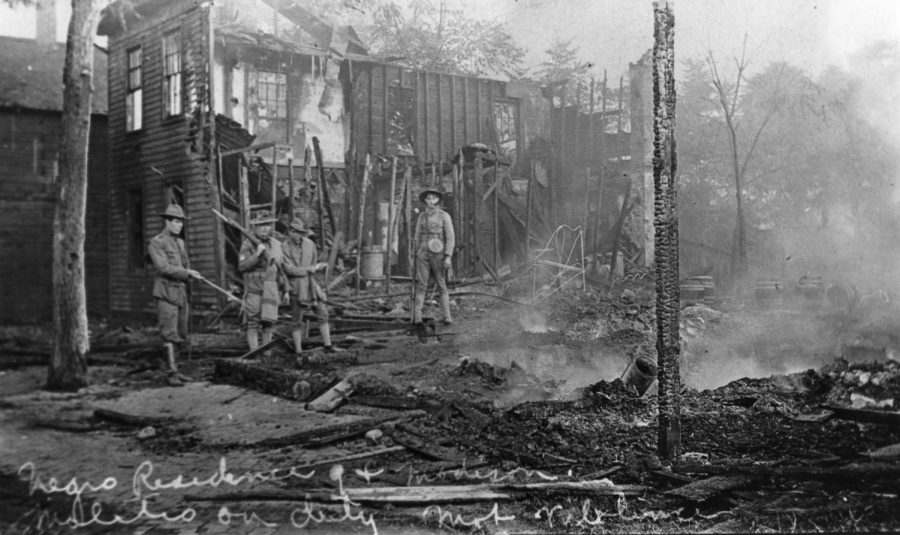Historians reflect on the Springfield Race Riot of 1908 during Black History Month
February 24, 2021
The Springfield Race Riot of 1908 was devastating for Black residents at the state capital and resulted in 16 deaths and 2,000 Black residents fled from the captial to escape violence and racial discrimination.
Dr. Pamela Smoot, an assistant professor of history at SIU, said the riot began on Aug. 14 1908 and lasted for two days.
“It began when two African Americans were arrested for two separate crimes. One of the guys names was George Richardson, he was accused of raping a white female; and the other gentleman’s name was Joe James, he allegedly killed a white man whose name was Clergy Ballard,” Smoot said.
Advertisement
Smoot said once the white community heard about what happened, a mob assembled. The county sheriff, Charles Werner and a white businessman, Harry Loper, moved the men out of the jail to protect them from the mob.
“They slid them out the backdoor and put them on a train and sent them to another jail in Bloomington, Ill. The mob was angry once they found out what happened, so on Aug. 14, 1908, there were approximately 5,000 white people, including some European immigrants, who began to attack Black people randomly,” Smoot said.
Gun stores were broken into and residents stole guns and ammunition to shoot Black residents. Two prominent Black residents were lynched. Scott Burton, an 84-year-old resident and leader in the Black community and William Donegan, who was married to a white woman.
“Eventually the Governor of Illinois, Charles Deneen, called in the National Guard to quell the violence. There were a number of Black folks killed and the two gentlemen, Scott Burton and William Donegan were lynched. There was property damage worth over $150,000. Homes were burned down and businesses were destroyed. And there were 150 people arrested, but only one person was convicted,” Smoot said.
The civil rights organization National Association for the Advancement of Colored People was founded on Feb. 12, 1909 as a result of the riots.
Erika Holst, a curator of history at the Illinois State Museum, said Black businesses and Black homes were primarily targeted and the mob used tactics to avoid destroying other white-owned property.
“They went to the Black business district, the Levee district. Black businesses were specifically targeted because white businesses and homes would put white sheets out the window and the mob would pass by them,” Holst said.
Advertisement*
Approximately 2,000 Black residents of Springfield fled after the riots since they were driven out of homes and businesses.
“One of the things that’s surprising to me is that about 2,000 people of color left Springfield in the wake of the race riot because they were driven out of homes and businesses and didn’t feel safe. For the next two months, there were attacks on Black people and Black property. The riots ended on Aug. 16, but the effort to drive people of color out of Springfield continued on,” Holst said.
Vincent “June” Chappelle, a curator of history at the Illinois State Museum said, despite Black residents fleeing the capital after the lynchings and riots, their problems weren’t limited to Springfield.
“The Black people that were fleeing needed to find somewhere else to go, but the outlying areas were racist,” Chappelle said.
Dr. James Lowen, an author and historian, said American race riots were perpetrated by white people against people of color until about 1943.
“All race riots in American history, until about 1943, were riots of white people against people of color. We tend to think race riots happen these days by Black folks, but they were all by white folks and some of them have been by white folks since then,” Lowen said.
Lowen said the Springfield riot resulted in nearby towns pushing out Black residents. The nearby sundown towns were Morton, Pekin, Washington.
“A number of other towns near Springfield became sundown towns. If they had a Black population, they pushed them out, and if they didn’t have a Black population, they made informal decisions to not have one,” Lowen said. “Springfield terrorized the Black community, two thirds of the Black community left in haste. Some of them came back within a few days, but some of them never came back.”
The Springfield Race Riot of 1908 wasn’t always a history lesson in Illinois schools. Lowen said students weren’t taught about the historical event until two middle school students, Lindsay Harney and Amanda Staab, did a project on it.
“The subject was airbrushed out of history in Springfield until two sixth grade girls did a project about it for national history day. The reason the girls knew about it was that one of their great-grandfather or uncles had been a reporter for one or two Springfield daily newspapers in 1908,” Lowen said. “They did a project on it and went to the library, what is now the Illinois Springfield Library, and the librarians never heard of it.”
The students were able to obtain minimal information about the Springfield Race Riot of 1908. After they did their report, they wrote a letter to the mayor and requested a historical marker as a way to remember the historical race riot.
“The city council performed a study commission, Lindsay Harney and Amanda Staab were on it, the NAACP was on it, professors were on it,” Lowen said. “They wound up at the race relations walking tour, there were six to eight monuments starting in downtown Springfield that talk about what the mob did. It’s a good statement of memory on the landscape, and it’s an apology.”
Courtney Alexander can be reached at [email protected] or on Twitter at ___Courtney_alex23______.
To stay up to date with all your southern Illinois news, follow the Daily Egyptian on Facebook and Twitter.
Advertisement



